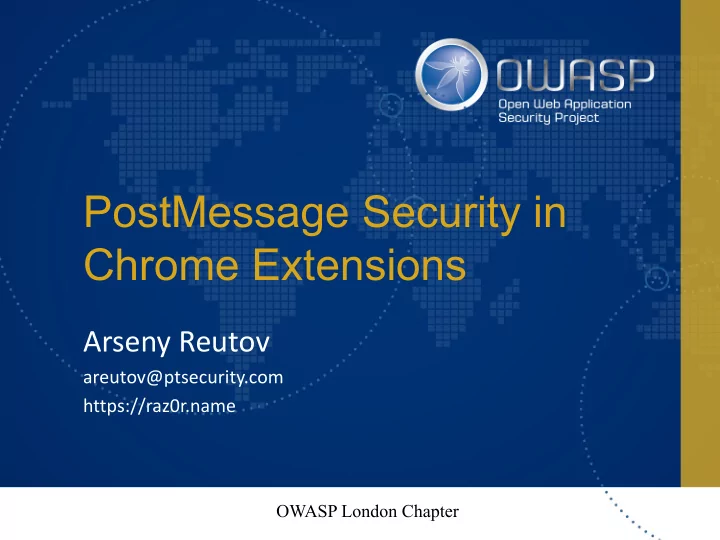

PostMessage Security in Chrome Extensions Arseny Reutov areutov@ptsecurity.com https://raz0r.name OWASP London Chapter
$ whoami • Web application security researcher at Positive Technologies • Member of Positive Hack Days (https://phdays.com) conference board • Occasional web security blogger (https://raz0r.name)
Agenda • Chrome extensions & their messaging • PostMessage security considerations • Mounting extensions analysis • The results! • The takeaways
Part I CHROME EXTENSIONS & THEIR MESSAGING
Chrome extensions ecosystem • Chrome Web Store is notoriously known in terms of security (unintuitive permissions dialogs, malware & insecure extensions)
Chrome extensions messaging
Extension manifest file { "name": “My Extension", "description": “My Super Chrome Extension", "version": “1.0", "background": { "scripts": [“js/background.js"] }, "content_scripts": [ { "matches": ["<all_urls>"], "js": ["js/jquery.js", "js/content.js"] } ], "permissions": ["tabs", "http://*/*", "https://*/*"] }
Part II POSTMESSAGE SECURITY CONSIDERATIONS
PostMessage API window.postMessage() method enables cross- origin communication someWindow.postMessage( "my message", // message data "*", // target origin );
PostMessage API Developer is in charge of origin validation window.addEventListener("message", receiveMessage, false); function receiveMessage(event) { if (event.origin !== "http://example.org") return; // checking origin host if (event.source !== window) return; // or origin window process(event.data); }
PostMessage API • If origin validation is absent or is flawed, an attacker’s message data can reach dangerous pieces of code. • See “The pitfalls of postMessage” by Mathias Karlsson for common origin validation bypasses.
PostMessage API • Unlike other DOM events, message propagation to listeners cannot be stopped via return false or stopPropagation() . • Extensions’ message listeners are not listed in Chrome Developer Tools.
PostMessage Attack Vectors Method 1: iframes var iframe = document.createElement("iframe"); iframe.src = "http://target.com"; iframe.contentWindow.postMessage("some message", "*"); Pros: stealthy Cons: killed by X-Frame-Options and framebusters
PostMessage Attack Vectors Method 2: opening a new window var targetWindow = window.open("http://target.com"); targetWindow.onload = function() { targetWindow.postMessage("some message", "*"); } Pros: not affected by X-Frame-Options Cons: more noisy
PostMessage in Chrome extensions • Chrome extensions use postMessage API to receive messages from external web sites (e.g. translator services) or within the same origin (especially in developer tools extensions) • postMessage data can be passed into background script context, and in some cases even reach OS via Native Messaging API
Part III MOUNTING EXTENSIONS ANALYSIS
The Research Steps • Download extensions (Web Development category only)
The Research Steps • Parse CRX files (https://github.com/vladignatyev/crx- extractor) • Convert to ZIP • Unpack
The Research Steps • Parse Manifest file, find content scripts • Parse each content script with Acorn JS parser (https://github.com/ternjs/acorn) • Look for postMessage listeners with an Acorn plugin
The Research Steps • Log each postMessage listener found into local elasticsearch
Part IV THE RESULTS
React Dev Tools • Have got postMessage protection just recently by an external PR:
React Dev Tools • Prior to the fix message was validated by just checking a special property (which is user controlled):
Ember Inspector • No origin validation, but, luckily, data does not reach sensitive parts.
AngularJS Batarang (Angular v1.x) • Developers have no clue how to validate origin
Augury (Angular v2.x) • Again, origin validation is just checking a magic string
Augury (Angular v2.x) • Augury employs interesting message serialization:
Augury (Angular v2.x) • XSS on any website with the extension installed
Augury (Angular v2.x)
LanSweeper Shell Execute
LanSweeper Shell Execute
LanSweeper Shell Execute
Part V THE TAKEAWAYS
The takeaways • For users: – do not install shady extensions from unknown publishers – check requested permissions
The takeaways • For developers: – pay attention to origin validation in message listeners – consider origin bypass tricks – do not rely on magic strings
The takeaways • For browsers: – should provide built-in origin validation – see getMessage proposal by @homakov
Thank you!
Recommend
More recommend